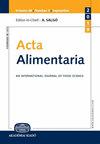Intuitive eating, diet quality, and nutritional status of vulnerable children living separated from their families: A pilot study
IF 0.8
4区 农林科学
Q4 FOOD SCIENCE & TECHNOLOGY
引用次数: 0
Abstract
Nutritional problems can be seen in children living separated from their families. This cross-sectional pilot study aimed to evaluate intuitive eating, diet quality, and nutritional status of children living separated from their families. A total of 55 adolescent girls aged 12–18 years participated in the study. Anthropometric measurements, biochemical data, and 24-h dietary recall data were collected. The Intuitive Eating Scale-2 (IES-2) and the Turkish version of the Healthy Lifestyle-Diet (HLD-TR) index were used. Participants were divided into two groups according to their scores on the diet quality index using the 50th percentile. Group 1 consisted of participants with a score of 25 points or less, and Group 2 consisted of participants with a score above 25 points. Waist circumference (72.0 (66–83), 65.0 (60–77)) was significantly higher in Group 1 (P < 0.05). IES–2 score (3.05 (2.85–3.40), 3.30 (3.12–3.90)) and two sub–factors; reliance in hunger and satiety cues (2.80 (1.80–3.40), 4.00 (2.60–4.60)) and body–food choice congruence (2.50 (2.00–3.50), 3.50 (3.00–4.50)) were higher in Group 2 (P < 0.05). After adjustment for body mass index, age, and energy intake, there was a significant positive correlation between IES-2 and HLD-TR scores (P = 0.029). In conclusion, it may be advantageous to resort to strategies that promote intuitive eating to reduce obesity and associated problems in this vulnerable group.与家人分离的弱势儿童的直觉饮食、饮食质量和营养状况:试点研究
与家人分离的儿童可能存在营养问题。这项横断面试点研究旨在评估与家人失散儿童的直觉饮食、饮食质量和营养状况。共有 55 名 12-18 岁的少女参加了这项研究。研究收集了人体测量数据、生化数据和 24 小时饮食回忆数据。研究采用了直觉饮食量表-2(IES-2)和土耳其版健康生活方式-饮食(HLD-TR)指数。根据饮食质量指数的得分,以第 50 百分位数为标准,将参与者分为两组。第一组由得分在 25 分或以下的参与者组成,第二组由得分在 25 分以上的参与者组成。腰围(72.0(66-83),65.0(60-77))明显高于第一组(P < 0.05)。第 2 组的 IES-2 得分(3.05(2.85-3.40),3.30(3.12-3.90))和两个子因子:对饥饿和饱腹提示的依赖(2.80(1.80-3.40),4.00(2.60-4.60))和身体-食物选择一致性(2.50(2.00-3.50),3.50(3.00-4.50))均较高(P < 0.05)。在对体重指数、年龄和能量摄入进行调整后,IES-2 和 HLD-TR 分数之间存在显著的正相关(P = 0.029)。总之,采取促进直觉饮食的策略可能有利于减少这一弱势群体的肥胖和相关问题。
本文章由计算机程序翻译,如有差异,请以英文原文为准。
求助全文
约1分钟内获得全文
求助全文
来源期刊

Acta Alimentaria
农林科学-食品科技
CiteScore
1.80
自引率
0.00%
发文量
47
审稿时长
18-36 weeks
期刊介绍:
Acta Alimentaria publishes original papers and reviews on food science (physics, physical chemistry, chemistry, analysis, biology, microbiology, enzymology, engineering, instrumentation, automation and economics of foods, food production and food technology, food quality, post-harvest treatments, food safety and nutrition).
 求助内容:
求助内容: 应助结果提醒方式:
应助结果提醒方式:


